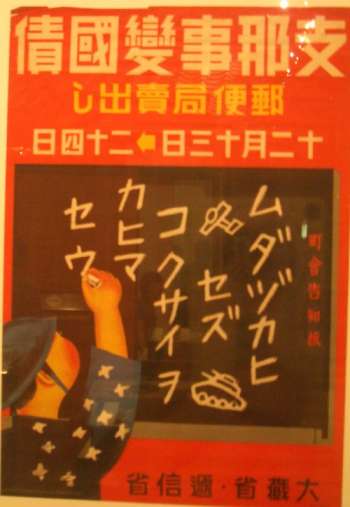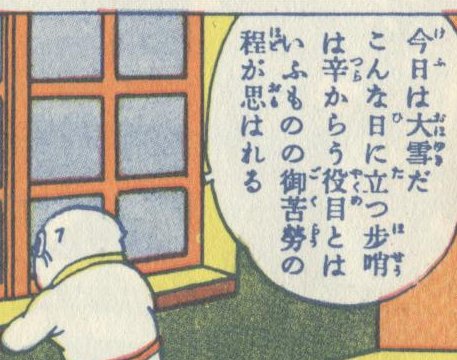
and
 |
| A WW2-era poster uses and |
|---|
Historical kana usage is the use of kana in Japanese prior to the written language reforms of the 1940s. (See Writing reforms in modern Japan.) Although the pronunciation of the language was the same as now, the spelling system was different. In Japanese this is referred to as kyūkanazukai (旧仮名遣い).
For example the kanji 京, now spelt きょう, kyō, was written きやう, "kiyau", and 轎, also now spelt きょう (kyō), was written けう, "keu". Verbs which now have an u (う) ending, such as kanau (叶う), were written with a fu (ふ), 叶ふ.
The change to the modern system was made to bring the writing into line with the modern pronunciation.
Dictionaries such as the Kōjien show the old readings as well as the modern.
Some of the differences between historical and modern kana usage are:
The historical kana usage represents the way words sounded during the Heian era (794-1185). However, some of the historical kana usages were simply mistakes. For example, 或ひは / 或ゐは aruiwa meaning "or" should have been 或いは. Similarly, 用ひる, mochiiru (use) should have been 用ゐる, and つくゑ (tsukue, (desk) should have been つくえ, according to the old pronunciations.
Not all unusual forms of kana are historical kana usage. For example, writing どじょう dojō (loach, a sardine-like fish), in the form どぜう dozeu, is not historical kana usage but slang which originated in the Edo period (1603-1867).
Verbs for which the dictionary form now ends in u (う) used to end in fu (ふ). For example, kanau (叶う) was written 叶ふ This extended to conjugations of the verb, so 叶はず for kanawazu (叶わず), 叶ひつつ for kanaitsutsu (叶いつつ), 叶へば for kanaeba (叶えば), etc.
The mashō (ましょう) verb ending was written maseu (ませう), and deshō (でしょう) was deseu (でせう).
These example words show historical kana usage with Sino-Japanese words.
| Current spelling | Old spelling | Kanji | Example words | |
|---|---|---|---|---|
| きょう (kyō) | きやう | 京 | 京都 | きやうと |
| けう | 教 | 教育 | けういく | |
| きゅう (kyū) | きう | 旧 | 旧悪 | きうあく |
| かん (kan) | くわん | 緩 | 緩慢 | くわんまん (see also What is the "kwa" in "kwaidan"?) |
| ちょう (chō) | てう | 鳥 | 啄木鳥 | たくぼくてう |
| しょう (shō) | せう | 昭 | 昭然 | せうぜん |
| そう (sō) | さう | 装 | 正装 | せいさう |
| お (o) | を | 悪 | 悪心 | をしん |
They can be seen in dictionaries like the Kōjien, where the entry for kōjō (荒城) (ruined castle) reads:
こう‐じょう【荒城】クワウジヤウ あれはてた城。
The old kana usage is the katakana クワウジヤウ.
Native Japanese words were also written using different kana prior to the reforms. For example,
| Examples | Meaning | Current Reading | Old Reading |
|---|---|---|---|
| 今日 | Today | きょう | けふ |
| 倒る | To fall | たおる | たふる |
| 使ひ, 遣ひ | Use | つかい | つかひ |
| 男 | Man | おとこ | をとこ |
Some historical kana usage survives in present-day Japanese. For example in names, the を (wo) or ほ (ho) kana are used to spell the name Kaori, as in かをり or かほり.
 |
| Old-fashioned spelling in pre-war cartoon "Norakuro" such as |
|---|
This is an edited excerpt from the newsgroup post referenced below.
A few centuries back, all cases of vowel + "u" assimilated to a single long vowel. The "u" may have been written originally as う, the end of a Sino-Japanese reading, or a pure Japanese う resulting from the loss of "k" in く, or else written ふ, a case of where the intervocalic "h [p/f]" had ceased to be pronounced. If the preceding vowel was "u", the sound became just a long "u". If it was an "i", as in the きう of きうかなづかひ or as in the case of 言ふ, the result was a long "u" with a "y" in front.
The actual kana spelling remained rather random (although there were schools of orthography based on all kinds of weird ideas) until rekishiteki kanazukai was recovered and given the nod during the Meiji period (1868-1912). Then about half a century ago, a spelling reform resulted in things being written (with some strange exceptions) as pronounced, and きう became きゅう. いふ became いう, which is an exception--we'd expect ゆう--perhaps due to its being a verb.
The other changes involving う and ふ were their being pronounced "o" after an "e" or an "o". In the case of えう and えふ, the frontness of the first vowel left a trace, the initial "y" sound of the resulting よう.
In the case of what would be like "(-)あう/あふ" in rekishiteki kanadukai, both vowels changed to a lower "o" than the case of "(-)お う/おふ" and "(-)えう/えふ"--we know this only because the Portuguese distinguished them in romanization--but before long the two kinds of long "o" merged into one.
Another oddity is the word for "get seasick/drunk" (now 酔う/よう). Early in the history of Japanese it was pronounced wepu and thus spelled ゑふ. Then "w" ceased to be pronounced except when followed by the lowest vowel, "a", and the original "p" changed to "h" and people quit pronouncing it in the middle of most words (what true exceptions can you think of besides あひる and あふれる?). The remaining pronunciation "eu" then went through the assimilation-to-long-vowel bit, resulting in "yoo". And finally, in the dialects that ultimately preserved a "(-)u" at the end of verbs, we end up with the pronunciation "you" (not "yoo") for the spelling よう.
This answer uses material by Jim Breen based on his Mini-FAQ. Paul Blay assisted with formatting when this was part of the "wiki sci.lang.japan FAQ" (see FAQ Format).
Copyright © 1994-2025 Ben Bullock
If you have questions, corrections, or comments, please contact Ben Bullock or use the discussion forum / Privacy policy

|

|

|

|

|
| Book reviews |
Convert Japanese numbers |
Handwritten kanji recognition |
Stroke order diagrams |
Convert Japanese units |